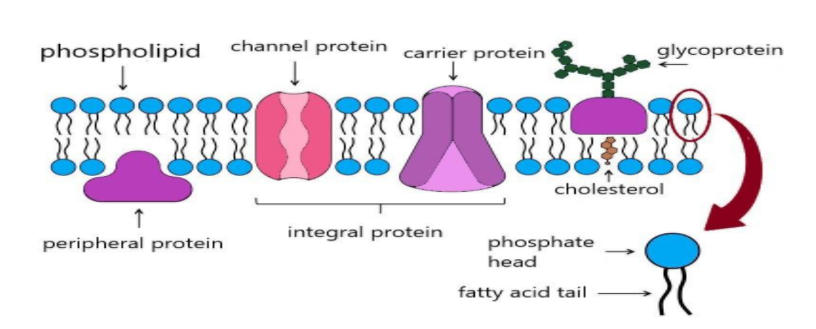
According to the modern concept, cell membrane is
A) Solid
B) Quasi Fluid
C) Fluid
D) Solidified sheath
Answer
503.4k+ views
Hint: The membrane is considered as selectively permeable when it allows the movement of water inside the cell or cell organelles. In this process, water from higher concentration passes to lower concentration because of the structure of the cell membrane.
Complete answer:
To answer this question, we have to know about the phospholipid bilayer of plasma membranes. Phospholipids build up the essential cell membrane structure. A single molecule of phospholipids has two distinct ends; a tail and a head. The head part represents a number of phosphates and it is hydrophilic in nature. That means that it prefers or attracted to the molecules of water. The tail part consists of two strings that are composed of fatty acid chains. The tail part is hydrophobic in nature or you can say they are ‘water haters’. A cell membrane arranges the phospholipid in a double layer that is considered as a lipid bilayer. The heads of hydrophilic phosphate are often arranged to reach water. In a cell the intracellular fluid and the extracellular fluid are both watery fluids. Membranes with phospholipid hydrophobic tails are arranged in a way that it holds it away from water. The nuclear envelope is the membrane that covers the nucleus of a cell, the membrane also consists of phospholipids arranged in a lipid bilayer same as that in the mitochondrial membrane, the portion of the cell that generates energy.
So, the above described fluid mosaic model is the most recently accepted structure of the membrane. The fluid mosaic model concludes that the cell membrane is quasi fluid that means, protein icebergs in lipid sea as the membrane model comprises lipid molecules with globular proteins like integral and peripheral proteins and sterols.

Therefore the correct answer is ‘B’. Quasi Fluid.
Note:Not all molecules can pass through the cell membrane because of lipid bilayer the components that dissolve in water cannot pass through it while components that get dissolved in fat can pass through. Carbon dioxide, urea, and fat can pass through the cell membrane very easily.
Complete answer:
To answer this question, we have to know about the phospholipid bilayer of plasma membranes. Phospholipids build up the essential cell membrane structure. A single molecule of phospholipids has two distinct ends; a tail and a head. The head part represents a number of phosphates and it is hydrophilic in nature. That means that it prefers or attracted to the molecules of water. The tail part consists of two strings that are composed of fatty acid chains. The tail part is hydrophobic in nature or you can say they are ‘water haters’. A cell membrane arranges the phospholipid in a double layer that is considered as a lipid bilayer. The heads of hydrophilic phosphate are often arranged to reach water. In a cell the intracellular fluid and the extracellular fluid are both watery fluids. Membranes with phospholipid hydrophobic tails are arranged in a way that it holds it away from water. The nuclear envelope is the membrane that covers the nucleus of a cell, the membrane also consists of phospholipids arranged in a lipid bilayer same as that in the mitochondrial membrane, the portion of the cell that generates energy.
So, the above described fluid mosaic model is the most recently accepted structure of the membrane. The fluid mosaic model concludes that the cell membrane is quasi fluid that means, protein icebergs in lipid sea as the membrane model comprises lipid molecules with globular proteins like integral and peripheral proteins and sterols.

Therefore the correct answer is ‘B’. Quasi Fluid.
Note:Not all molecules can pass through the cell membrane because of lipid bilayer the components that dissolve in water cannot pass through it while components that get dissolved in fat can pass through. Carbon dioxide, urea, and fat can pass through the cell membrane very easily.
Recently Updated Pages
Master Class 11 Economics: Engaging Questions & Answers for Success

Master Class 11 Business Studies: Engaging Questions & Answers for Success

Master Class 11 Accountancy: Engaging Questions & Answers for Success

Master Class 11 English: Engaging Questions & Answers for Success

Master Class 11 Computer Science: Engaging Questions & Answers for Success

Master Class 11 Maths: Engaging Questions & Answers for Success

Trending doubts
Which one is a true fish A Jellyfish B Starfish C Dogfish class 11 biology CBSE

State and prove Bernoullis theorem class 11 physics CBSE

1 ton equals to A 100 kg B 1000 kg C 10 kg D 10000 class 11 physics CBSE

In which part of the body the blood is purified oxygenation class 11 biology CBSE

One Metric ton is equal to kg A 10000 B 1000 C 100 class 11 physics CBSE

Difference Between Prokaryotic Cells and Eukaryotic Cells




